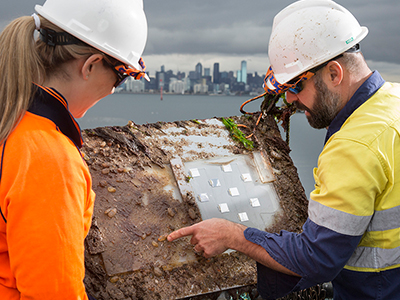Novel approach to keep hulls free from fouling

DST is exploring methods of combating biofouling using ultraviolet (UV) light.
Biofouling is the accumulation of biomass on submerged surfaces. It has been a problem in the marine world for centuries. On the hull of ships, it increases drag and fuel consumption; internally it can block water inlets for cooling or firefighting operations. Many different anti-biofouling technologies are in use, but most of them have severe drawbacks, such as pollution of the environment, or a limited effectiveness when the object is stationary in the water.
DST researcher Richard Piola has been working with Dutch company Royal Philips on a novel approach, based on the use of ultraviolet (UV) light, to keep surfaces free from biofouling.
"The fundamental idea is to have a type of coating which emits UV light outward from the surface as opposed to traditional methods of UV antifouling that direct an external light onto a surface," Piola explains.
His team has been testing the technology at a site in Melbourne and is now testing it in tropical waters near Cairns.
"Test results are very consistent; surfaces are kept completely free from fouling for prolonged periods, regardless of location or circumstances. And this is achieved at very low power levels at the surface, in the order of 1mW of UV light per square metre."
This system works because the DNA of the colonising organisms absorbs UV light. When this occurs chemical bonds are broken, genetic codes are damaged and the organisms cannot replicate.
Right place, right time
Piola has focused on invasive marine species and biofouling (the topic of his doctoral thesis) over the last seven years at DST.
"Biofouling has a big impact on shipping and marine infrastructure – it affects fuel efficiency, maintenance and the general operational availability of marine vessels and infrastructure," Piola says.
"Some estimates of the fuel penalty of a heavily fouled hull of a ship are as high as 50% extra, so finding an effective way to combat biofouling will have ongoing benefits for our navy."
The Philips collaboration came about, as many good ideas do, via a conference. While UV light has been used to control water-borne organisms for decades, Piola became aware of Philips's novel use of LEDs embedded in silicone films to turn underwater surfaces into UV light emitters.
"We saw that this could be applied to complex-shaped vessel niche areas (for example "sea chests") and other surfaces such as sensors. These are areas that have always been problematic as they're not conducive to the effective use of traditional antifouling coatings that perform well on hulls. Philips were interested in testing the concept under a wider range of environmental conditions, and [they] were enthusiastic about us joining the research because of Australia's expansive coastline and wide range of biofouling pressures."
Exceeding expectations
Following a pilot study on a first generation panel, and after providing feedback into the redesign of a second generation panel, testing over the last year and a half has shown the system works well. Piola has tested the UV panel, which has ten LEDs in a slab of silicone of about 30 × 30 cm, in a number of scenarios such as static and flowing water and is now trialling a panel at DST's tropical exposure site.
"At the Melbourne marine site, we bring the test item up every month for evaluation. It is showing some signs of wear and tear, and a degradation in the LEDs has seen a reduction in the effective antifouling area over time. This is expected as the optical properties of the silicone have changed over time, but we have exceeded Philips's expectation of what would be possible, and shown that this technology is really promising."
The flexible silicone covering can be moulded to fit different shapes, making it a novel solution that will be useful in a number of situations. It's also non-toxic, unlike some traditional techniques.
"Our results indicate that, given energy losses, a realistic consumption of 1mW per square metre is required for effective biofouling and that's really quite low. We haven't done a study of the duty cycles required, in other words how often the light needs to be turned on, but indications are that it doesn't need to be continuous, even an hour a day is enough to kill anything settling during the intervening periods. That needs further assessment, and the sweet spot will depend on the environment."
Philips has partnered with AkzoNobel to commercialise the technology. Going forward, the focus will be on optimising the technology for low power, covering larger areas, and making the films thinner and more flexible.
Optical options
DST is looking at extending this basic UV radiation concept into the area of optical sensor anti-fouling. There are currently various methods such as wipers used to protect optics but they aren't very effective.
Piola's team is working with the Australian Institute of Marine Science in Townsville to examine the potential of using internally refracted UV light to keep the lens of optical sensors free of fouling.

